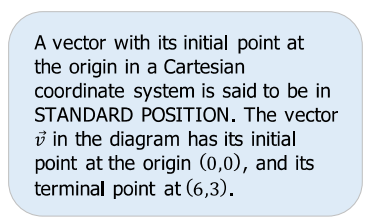2.1: Vectors
- Page ID
- 125028
\( \newcommand{\vecs}[1]{\overset { \scriptstyle \rightharpoonup} {\mathbf{#1}} } \)
\( \newcommand{\vecd}[1]{\overset{-\!-\!\rightharpoonup}{\vphantom{a}\smash {#1}}} \)
\( \newcommand{\id}{\mathrm{id}}\) \( \newcommand{\Span}{\mathrm{span}}\)
( \newcommand{\kernel}{\mathrm{null}\,}\) \( \newcommand{\range}{\mathrm{range}\,}\)
\( \newcommand{\RealPart}{\mathrm{Re}}\) \( \newcommand{\ImaginaryPart}{\mathrm{Im}}\)
\( \newcommand{\Argument}{\mathrm{Arg}}\) \( \newcommand{\norm}[1]{\| #1 \|}\)
\( \newcommand{\inner}[2]{\langle #1, #2 \rangle}\)
\( \newcommand{\Span}{\mathrm{span}}\)
\( \newcommand{\id}{\mathrm{id}}\)
\( \newcommand{\Span}{\mathrm{span}}\)
\( \newcommand{\kernel}{\mathrm{null}\,}\)
\( \newcommand{\range}{\mathrm{range}\,}\)
\( \newcommand{\RealPart}{\mathrm{Re}}\)
\( \newcommand{\ImaginaryPart}{\mathrm{Im}}\)
\( \newcommand{\Argument}{\mathrm{Arg}}\)
\( \newcommand{\norm}[1]{\| #1 \|}\)
\( \newcommand{\inner}[2]{\langle #1, #2 \rangle}\)
\( \newcommand{\Span}{\mathrm{span}}\) \( \newcommand{\AA}{\unicode[.8,0]{x212B}}\)
\( \newcommand{\vectorA}[1]{\vec{#1}} % arrow\)
\( \newcommand{\vectorAt}[1]{\vec{\text{#1}}} % arrow\)
\( \newcommand{\vectorB}[1]{\overset { \scriptstyle \rightharpoonup} {\mathbf{#1}} } \)
\( \newcommand{\vectorC}[1]{\textbf{#1}} \)
\( \newcommand{\vectorD}[1]{\overrightarrow{#1}} \)
\( \newcommand{\vectorDt}[1]{\overrightarrow{\text{#1}}} \)
\( \newcommand{\vectE}[1]{\overset{-\!-\!\rightharpoonup}{\vphantom{a}\smash{\mathbf {#1}}}} \)
\( \newcommand{\vecs}[1]{\overset { \scriptstyle \rightharpoonup} {\mathbf{#1}} } \)
\( \newcommand{\vecd}[1]{\overset{-\!-\!\rightharpoonup}{\vphantom{a}\smash {#1}}} \)
Vectors are fundamental objects in applied mathematics; they efficiently convey information about a mathematical or physical object. Let’s get a sense of what they are.
A VECTOR is a representation of an object that has both direction and magnitude. By direction, we mean the place toward which something faces, and by magnitude, we mean the size of something.
A vector can be depicted visually by an arrow, with an initial point called the tail and a terminal point called the head. The length of the arrow represents the vector’s magnitude.


An example of a vector is a car’s velocity. Velocity is a vector since it has both magnitude (speed) and direction. A car might be moving west at 60 mph. Other examples of vectors are displacement, acceleration, and force.
The temperature of some medium is not a vector since it has only magnitude. But if the medium is being heated, its temperature is increasing and has a direction; it is going upward. The increase or decrease in temperature is a vector.
Vectors in Standard Position


Components of a Vector


For example, the vector \(\vec{v}\) in the diagram can be broken into two components,
- its horizontal, or \(x\)-component, and
- its vertical, or \(y\)-component.

The vector \(\vec{v}\) in component form is expressed using angle brackets as \(\vec{v}=\langle 3,6\rangle\), where
- the first component, 3 is the length and direction of its \(x\)-component, and
- the second component, 6 is the length and direction of its \(y\)-component.
The vector \(\overrightarrow{u}\) in the picture below has
FIRST COMPONENT = (terminal \(x\)-value) – (initial \(x\)-value) = \(2-7=-5\), and
SECOND COMPONENT = (terminal \(y\)-value) – (initial \(y\)-value) = \(4-6=-2\),
so that \(\overrightarrow{u}=\left\langle -5,\left.-2\right\rangle \right.\).
we get <-5,-2>." src="/@api/deki/files/97342/clipboard_eaa414d12e539b2aa26d4cc28d0dc560e.png">
Row and Column forms of a Vector
Vectors are represented by a single column matrix or a single row matrix. The vectors \(\overrightarrow{v}=\left\langle 3,\left.6\right\rangle \right.\), and
\(\overrightarrow{u}=\left\langle -5,\left.-2\right\rangle \right.\) above, can be represented by the 2x1 row matrix and the 1x2 column matrix, respectively as
\[\vec{v}=\left[\begin{array}{ll}
3 & 6
\end{array}\right] \text { and } \vec{u}=\left[\begin{array}{l}
-5 \\
-2
\end{array}\right] \nonumber \]
Equal Vectors
Two vectors are EQUAL if they have the same direction and magnitude. They may start and end at different positions, but their representing arrows will be parallel.

In the diagram vectors \(\vec{a}\) and \(\vec{b}\) are equal but appear in different locations in the x-yplane.
Try These
Express the vectors \(\vec{v}\) and \(\vec{u}\) in component form.

- Answer
-
\(\overrightarrow{v}=\left\langle -3,\left.2\right\rangle \right.\) and \(\overrightarrow{u}=\left\langle 13,\left.3\right\rangle \right.\)
Explain why the two vectors are equal.

- Answer
-
Two vectors are equal because they have the same direction and magnitude.

